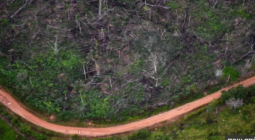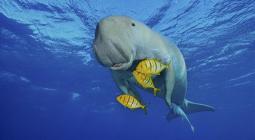Horizon scan: the opportunities and threats facing Earth’s biodiversity

From floating solar farms and volcanic cement to deep-sea mining and asexual reproduction, 15 things to watch
It is no secret that the diversity of life around us is plummeting. Scientists declared more than 100 species to be extinct in 2020 alone. That’s bad news not only for the creatures themselves but for those of us (that would be all of us) who rely on them for food, to produce oxygen, to hold soil in place, to cleanse water, to beautify our world and so much more. According to the World Economic Forum, nature plays a key role in generating more than half of global GDP.
So what can we do to reduce future harm? One big thing is to identify emerging threats and opportunities to protect biodiversity and proactively shape policies and actions to prevent harm early on. To this end, a group of scientists and conservation practitioners led by William Sutherland, a professor of conservation biology at the University of Cambridge, create and publish a “horizon scan” of global trends with impacts for biodiversity each year. Read on for this year’s top picks.
Floating solar
One of the big challenges for solar power is finding a place to put large arrays of photovoltaic panels. The notion of siting them on water rather than land has taken off dramatically in recent years, with more than 300 installations in place around the world. The approach offers a number of benefits to biodiversity. It saves land resources that might otherwise be covered with solar panels, and it can reduce algal blooms on waterways. It can reduce the demand for other habitat-harming energy sources such as hydropower, and the evaporative cooling water makes the panels more efficient. All that said, the potential implications – positive and negative – for aquatic and marine ecosystems are still to be determined.
Energy through the air
Power lines and the poles and towers that carry them are staples of civilisation. Imagine being able to replace them with devices that transmit electricity through the air instead. That vision is closer to becoming reality thanks to innovations in materials and technologies that create and direct beams of energy. Think wireless smartphone charging writ large. Deployment of long-distance wireless energy infrastructure could reduce the harms that conventional hardware pose to wildlife, such as collision risks for birds and bats. On the downside, it could also stimulate energy use and make it easier to live in remote locations, hastening the destruction or disruption of our planet’s few remaining untrammelled areas.
Soaring satellites
Think human impacts on biodiversity are limited to the biosphere? Think again. More than 2,000 communications satellites orbit our planet, and under current plans the total could reach 100,000 in the next 10 years. The process of deploying and decommissioning these extra-planetary objects can disrupt the stratospheric ozone layer; deposit aluminium in, and otherwise modify the chemical composition of, the upper atmosphere; and alter Earth’s albedo – its ability to reflect sunlight. These alterations in turn affect the amount and type of radiation that hits the surface of our planet. As satellite deployment soars, implications potentially loom large for the climate, exposure to ultraviolet light and other conditions that affect the wellbeing of living things.
Nitrogen boom?
The pursuit of alternative transport fuels has taken many twists and turns, all with ancillary costs as well as benefits. Recent attention has turned to ammonia as a fuel for shipping. It can power fuel cells or engines. It has almost double the energy density of hydrogen, and poses fewer issues in terms of storing and transporting fuel to where it’s needed. The problem? Ammonia takes lots of energy to produce and can cause environmental harm if not burned completely. As interest in ammonia fuel grows, the authors caution against false claims of it being a “zero carbon” fuel and point out potential downsides, such as increased air pollution, that might accrue from its use.
Airborne DNA detection
Increasingly sophisticated tools for detecting and identifying DNA are able to pinpoint the presence – or even past presence – of all kinds of organisms from bits of their genetic material floating through the air. This capability opens the door to a wide range of conservation-assisting endeavours, from characterising the members of a particular ecological community and locating rare or endangered species, to tracking the expansion of the range of invasive organisms and nailing perpetrators of the illegal wildlife trade. So-called “eDNA” bio-monitoring is already in use for detecting the presence of micro-organisms, plants and fungi, and it appears to be feasible for tracking some animals as well. As the technology expands, so will its applications to efforts to understand and protect biodiversity.
Refrigerant redux
Widespread efforts have taken place in recent decades to reduce the use of hydrofluorocarbons (HFCs) in air conditioners, refrigerators and other cooling systems because of their capacity to contribute to global warming. Unfortunately, one of the top replacement chemicals, hydrofluoroolefins (HFOs), appear to have plenty of environmental issues of their own. They form chemicals that pollute water and air as they decompose, and some produce potent greenhouse gases. Environmental contamination with this long-lasting HFC substitute appears to on the rise. Unless regulation of the deployment and decommissioning of refrigerants improves quickly and dramatically, we risk further contributing to climate change with a shift in practice intended to help reduce its risks.
Volcanoes, meet cement
Production of clinker, a key ingredient of cement, is bad for the climate and bad for biodiversity. It requires mining limestone, harming habitats. The process of turning limestone into clinker also releases huge amounts of planet-warming carbon dioxide, from the energy required to heat it up and the gas limestone releases in the process. Cement production is already responsible for about 8% of global carbon dioxide emissions, and demand is expected to grow. Using volcanic material in place of limestone could reduce greenhouse gas impact and would have the possible additional benefit making cement less prone to cracking. The researchers write, however, that we need to weigh the environmental costs of mining and transporting volcanic material against the benefits of reducing limestone use.
Insecticide whack-a-mole
Neonicotinoids are a class of chemicals that kill insects by disabling their nervous systems. Used to control pests in agriculture, they have come under fire in recent years for threatening populations of bees and other desirable insects. As they have been banned in the EU and elsewhere, other similar-acting insecticides have emerged. These substitutes, including sulfoxaflor and flupyradifurone, appear also to harm bees and some other desirable insect species, potentially posing new threats to insect biodiversity.
Spreading without sex
Some insects and other invertebrates have evolved a novel solution to the “can’t get a date” problem. They can reproduce without sex. The process, known as parthenogenesis, allows them to make more of their species when mates are scarce or absent. It also dramatically enhances their ability to gain a foothold in new territory if accidentally introduced there. At least one invertebrate, the marbled crayfish, evolved the ability to reproduce asexually in captivity and is now spreading rapidly across Europe, Africa and Asia, carrying with it disease that harms native species. As we cultivate other invertebrates for food or hobbies, we raise the risk that something similar might happen with other species.
Plant-forward food
Animal agriculture is a major source of greenhouse gas emissions, and “plant-forward” diets are gaining increased attention as a waynot only to be healthier ourselves but also to help our planet be healthier as well. China, for one, is taking it a step further. Rather than simply touting meals heavy on fruits and veg, it has committed to cut its citizens’ meat consumption in half by 2030. Media campaigns and bans in some settings have already contributed to a decline in meat consumption, and the initiative has boosted synthetic meat innovation. The country’s plant-based meat industry is expected to grow by 20 to 25% a year in the foreseeable future.
All together now
Volunteer groups, non-profit organisations, small-town governments and other local entities can be a valuable source of support for people living in rural areas. It turns out they can be a valuable source of support for other living things too. The number of social institutions globally has grown from 500,000 in 2000 to 8.5m in 2020, providing support for the sustainable management of about 300m hectares (700m acres) of forests, farmland and waterways. If the trend continues, it bodes well for biodiversity conservation as more landis managed in ways that keep it, and the plants and animals that inhabitit, thriving.
Wetland attitude adjustment
The East Asian–Australasian flyway, which extends along the eastern coast of Asia and Australia through New Zealand, is one of the world’s top hotspots for diversity and sheer numbers of waterfowl and other water-loving birds, including critically endangered species. With huge development under way in China, one of the countries with the most wetlands in the world, it’s also among the most threatened. Many areas have been transformed into farmland and cities in the past decade. Recently, however, several changes are starting to shine an optimistic light. The UN has provided a new level of protection to highly significant wetlands in Korea and China by adding them to its roster of world heritage sites, and China has begun to invest in protecting key wetlands. If this trend continues and other countries follow suit, it could spell welcome relief for waterbirds throughout much of eastern Asia and the western Pacific.
Mangrove revival
The mangrove forests that coat coastlines in the tropics and subtropics harbour abundant plant and animal species that thrive at the intersection of land and sea. Development has decimated many in recent decades, destroying the biodiversity-nurturing and carbon-sequestering services they provide. In recent years, however, the tide has turned. Conservationists’ efforts to restore and preserve these rich habitats have helped reduce loss, and they have also the accidental beneficiaries of other ecosystem changes. As inland forests are cut, erosion moves soil toward the coast where it can nurture new mangroves, and climate change is creating more of the warm habitat they need. Together, these changes have reduced mangrove loss to near zero, though local areas of depletion continue.
Tidal zone tribulations
Intertidal zones, the areas of coast across which water advances and recedes with the tides, experience daily fluctuations in temperature, water level, salinity, physical disruption and predation. Now they have another variable to cope with: heatwaves. Record temperatures in the US Pacific north-west in June 2021 left mussels, clams, oysters, barnacles, sea stars, rockweed and more dead along thousands of miles of coastline. And that’s not all. Climate change threatens to change the salinity of these complex and fragile ecosystems as precipitation patterns change and polar ice melts. If this keeps up we’ll have more than a stinky mess. The complex ecosystems and the services they provide – stabilising coasts, providing food, providing habitat, protecting water quality – will be fried, too.
Treasure – and trouble? – beneath the seas
The seabed beneath Earth’s oceans harbours abundant bounties of precious metals and other mineable materials. New technologies have made it possible to extract such materials, and one country, Nauru, recently announced plans to permit deep-sea mining. This announcement means that the International Seabed Authority must either set up specific ocean mining regulations or commit to reviewing applications under established, more general UN conventions. Ocean mining may reduce pressure to disrupt land habitat, but it also opens the door to new assaults on unique deep-sea ecosystems and the living things they harbour.
cover photo: A residential development encroaches on a mangrove swamp near Tin Shui Wai in Hong Kong. Photograph: Jérôme Favre/EPA






